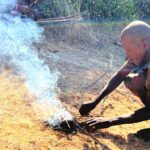Mankind’s use of fire goes back an extraordinary length of time. From humble collecting and guarding natural fires to producing fire by sparks or friction took about 1,5 million years. For more than 500,000 years, mankind has been producing fires by the abovementioned methods. Only since about 200 years ago has fire been made by other mechanical, chemical, or electrical methods.
2,000,000 years ago:
It is debatable since when our species has been using the power and might of fire. One thing is sure: Homo erectus already guarded natural fires, for example, those caused by lightning strikes or volcano outbreaks, in the form of eternal campfires, which also provided light.
500,000 years ago:
Burning fat-pine splints served as the oldest movable artificial light source. They are documented to have been used everywhere north of the equator, from Scandinavia to Siberia, from the Alps to the Himalayas. Torches later developed from these splints.
40,000 years ago:
During the last ice age in Europe, the Cro-Magnon people used stone bowls for lighting. In principle, these were the first oil lamps in which wicks burn liquid animal fat (tallow or blubber).
5,000 years ago:
Candles were invented independently in India, Mesopotamia, and China. They were created by dipping a wick made of straw, hemp, reed, or papyrus in tallow—and later also in beeswax—and thus soaking it with fuel. The following illustration shows the variety of possibilities for producing torches and candles.

- No. 1. Folded palm leaf used as a torch. East Indies.
- No. 2. Stormy petrel, burned in the Orkney Islands for light
- No. 3. Candlefish in a split stick, burned for light. Alaska
- No. 4. Torch made of birch bark. Iroquois Indians
- No. 5. Torch made of splint fat-pine knots. Virginia
- No. 6. Torch made of a bundle of slivers of fat pine. Southern Indians
- No. 7. Torch made of dammar gum wrapped in palm leaves. Malays
- No. 8. Torch or ” link ” made by soaking rope in resin. Europe in the Middle Ages
- No. 9. Torch composed of cords soaked in fat or wax. Europe, sixteenth century
- Nos. 10 and 11. Cord soaked in fat or wax, coiled, for lighting. England,
- No. 12. Rush soaked in grease, forming a primitive candle. England
- No. 13. Stick smeared with grease for illumination. Mongolia
- No. 14. Mass of fat formed upon a stick, wound a wick of fiber. Kashmir, India
- No. 15. Tallow dip with rush wick, later cotton. Northern Europe.
- No. 16. Candles formed of wax; wick of fiber. Japan and North Africa.
- No. 17. Molded candles. Patent candles of stearin, paraffin, and wax, and decorated candles. 19th century
Source: Walter Hough (1922). A synoptic series of objects in the United States National Museum illustrates inventions’ history. Proceedings of the United States National Museum 60 (2404): 1-47, 56 pl. The picture can be accessed via this link.
2,000 years ago:
Plinius describes the transport and use of fire with Giant Fennel (Ferula communis) stems. However, the author of this article tested whether transporting fire is possible with this plant’s stems. The result was sobering, and this possibility was busted.

200 years ago:
The first lighter was invented in 1823 by a German chemist. This started the era when fire could be reliably created in an instant. The first successful friction match was invented in 1826 by an English chemist. About 25 years later, Safety Friction Matches were invented in Sweden, which, combined with clever marketing, dominated the world market after that.
120 years ago:
Auer von Welsbach, an Austrian industrialist, invented Ferrocerium metal, which was used as flint steel for creating sparks. Many Bushcrafters and Survivalists nowadays (2023) consider similar flint steels—now called fire-steel rods—a rustic, old way of making fires.
100 years ago:
My grandmother, who lived in a secluded valley in the Alps, still used flint and steel plus tinder fungus (Fomes fomentarius) daily to light their kitchen fireplace.
70 years ago:
The primary fuel source for lighters became butane gas – with the emergence of throw-away lighters.
Lessons learned from the historical overview of man’s use of fire:
- Homo erectus already guarded natural fires abt. 2 Mio years ago
- For more than 500,000 years, mankind has been producing fires by sparks or friction
- Only in the last 200 years has fire been created by other mechanical, chemical, or electrical methods
- Even 100 years ago, fire was still regularly produced in secluded locations by flint and steel or friction
- Throw-away lighters have only been commonplace for about 70 years now
.




